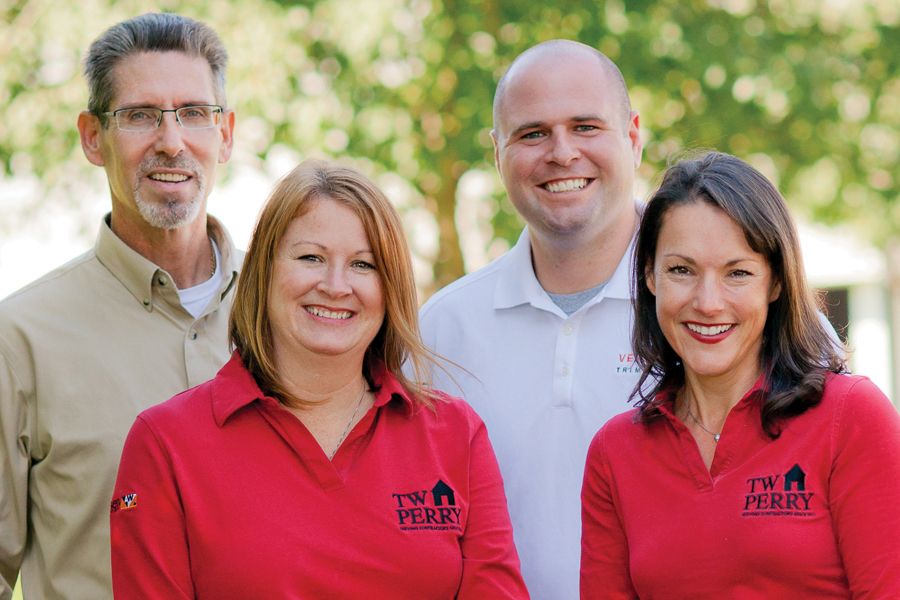Setting the Tone
Before they did anything else, Farina and Purdy struggled with creating a message and a brand for the show. “We wanted to have a message that was consistent, and that thought process took a lot of time,” Purdy says. The two women decided they wanted to appeal to contractors more than anyone else since they were TW Perry’s customers. “Our specialty isn’t communicating with homeowners,” says Farina.
While the contractors quickly picked up on that approach, the vendors weren’t as fast. Farina says more than one vendor asked her whether the event was created for homeowners or for contractors.
The dealer says it also marketed the event internally to its staff, along with vendors and contractors. It used the advice it received from those three sources in building its advertising campaign. TW Perry says the results of the feedback also helped the advertising campaign reach architects, subcontractors, suppliers, and realtors.
Even picking the photo to accompany the messages in the advertisements was a huge decision. Eventually TW Perry settled on one showing a gorgeous home–built in part with products from its three premier sponsors.
Advertising for the event, which began about a month prior, included ads on the backs of buses, which TW Perry says provided great visibility at low cost. The dealer also bought advertising in local newspapers, created commercials for local radio and television stations, and hung banners at its Chevy Chase and Gaithersburg locations.
Along with its own promotions, TW Perry found it had to help the contractors with their own advertising and marketing, since most had no experience with that. Purdy says she and Farina gave the contractors advice on how to attract passersby and generate interest at the show. The company provided the contractors suggestions on how to display their work, games that could draw in crowds, staffing, and where to get marketing materials. Each participant worked from a booth that was 10 feet wide and 7-1/2 feet deep.
“We had some people tell us they had never done a home show,” Purdy says. Over time, many of the contractors started to take pride in their displays and booths.
Real Results
Each contractor averaged three leads from the show and, at the time of the entry’s submission, 14 had closed on jobs estimated to be worth more than $400,000. One contractor, Dave Barclay, closed a deal to build an $80,000 deck based on a lead he got from the show. According to Farina, Barclay walked away with a whopping 12 leads and closed on two, including the deck.
For the most part, the show was a success, but it didn’t go off without any hiccups. The signs displaying the company names that hung in each booth arrived on the morning of the show without holes in the corners from which to hang them. Purdy had to go to a couple of office supply stores and get materials for hanging.
Afterward, TW Perry surveyed participants and took in feedback on how to improve things and make it better next time around. Location, floor plan, and time of day were the biggest issues with some participants. Despite Farina and Purdy’s wedding-like booth planning, some in the party said the layout didn’t create as much traffic through the back parts of the building as they hoped.
A few participants also took issue with TW Perry hosting the event at the Montgomery County Fairgrounds, whose entrances, Farina admits, are hard to find when the fair isn’t taking place. The dealer would like to host the event near the Northwest quadrant of Washington, D.C., which Farina says is a big driver of its business. At least two participants suggested the same thing in the survey.
“We’ll certainly evaluate all those things going forward,” says Farina.
Such an event is a large undertaking and it takes a certain type of person–or in this case, a team–to make a home show successful. “Insanity,” laughs Farina when describing what traits a person needs to be successful in running such an event.
“You can’t ask questions, you just have to do it,” Farina says. “We put it on the calendar and did it.”
While Farina and Purdy planned everything, they didn’t shy away from accepting some manpower help from TW Perry by getting a number of employees to volunteer at the show. Farina says they even had a driver on site to run supplies between the fairgrounds and corporate headquarters. The work that went into the show, though, wasn’t enough to turn Purdy or Farina away from doing it again. They say some participants are even encouraging them to do a fall show, which will not happen anytime soon, but may occur in the future, according to Farina.
“I feel like we learned a lot from this first show and going forward we can work out a lot of the kinks,” Farina says. “It was daunting. It was a lot to take on for two people.”
One of the key things that TW Perry took away from the event was the feeling that it helped to build loyalty with its customers by rewarding them. “There are no lumberyards in our area consistently doing things to grow our customers’ businesses,” says the company’s awards entry. “We are building loyalty by acting as advocates for their business.”



